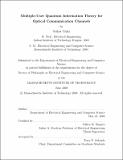| dc.contributor.author | Guha, Saikat | |
| dc.date.accessioned | 2008-05-20T21:03:55Z | |
| dc.date.available | 2008-05-20T21:03:55Z | |
| dc.date.issued | 2008-05-20T21:03:55Z | |
| dc.identifier.uri | http://hdl.handle.net/1721.1/41840 | |
| dc.description | Thesis Supervisor: Jeffrey H. Shapiro
Title: Julius A. Stratton Professor of Electrical Engineering | en |
| dc.description.abstract | Research in the past decade has established capacity theorems for point-to-point
bosonic channels with additive thermal noise, under the presumption of a conjecture
on the minimum output von Neumann entropy. In the rst part of this thesis,
we evaluate the optimum capacity for free-space line-of-sight optical communication
using Gaussian-attenuation apertures. Optimal power allocation across all the spatiotemporal
modes is studied, in both the far- eld and near- eld propagation regimes.
We establish the gap between ultimate capacity and data rates achievable using classical
encoding states and structured receivers. The remainder of the thesis addresses
the ultimate capacity of bosonic broadcast channels, i.e., when one transmitter is used
to send information to more than one receiver. We show that when coherent-state
encoding is employed in conjunction with coherent detection, the bosonic broadcast
channel is equivalent to the classical degraded Gaussian broadcast channel whose capacity
region is known. We draw upon recent work on the capacity region of the
two-user degraded quantum broadcast channel to establish the ultimate capacity region
for the bosonic broadcast channel, under the presumption of another conjecture
on the minimum output entropy. We also generalize the degraded broadcast channel
capacity theorem to more than two receivers, and prove that if the above conjecture
is true, then the rate region achievable using a coherent-state encoding with optimal
joint-detection measurement at the receivers would be the ultimate capacity region
of the bosonic broadcast channel with loss and additive thermal noise. We show that
the minimum output entropy conjectures restated for Wehrl entropy, are immediate
consequences of the entropy power inequality (EPI). We then show that an EPI-like
inequality for von Neumann entropy would imply all the minimum output entropy
conjectures needed for our channel capacity results. We call this new conjectured
result the Entropy Photon-Number Inequality (EPnI). | en |
| dc.description.sponsorship | The Army Research Office, DARPA and the W. M. Keck Foundation Center for Extreme Quantum Information Theory (xQIT) at MIT. | en |
| dc.language.iso | en_US | en |
| dc.relation.ispartofseries | #723 | en |
| dc.relation.ispartofseries | Technical Report (Massachusetts Institute of Technology, Research Laboratory of Electronics); | en |
| dc.title | Multiple-User Quantum Information Theory for Optical Communication Channels | en |
| dc.type | Technical Report | en |
